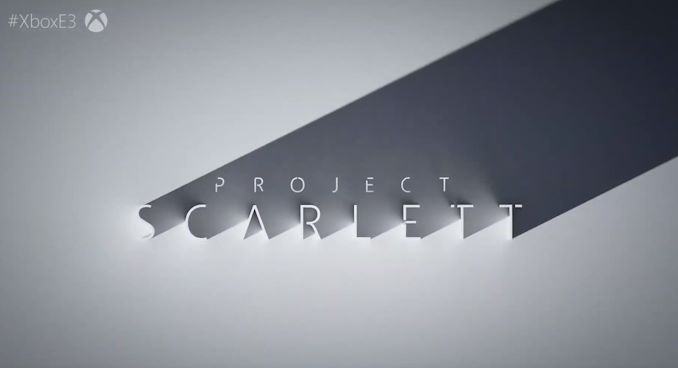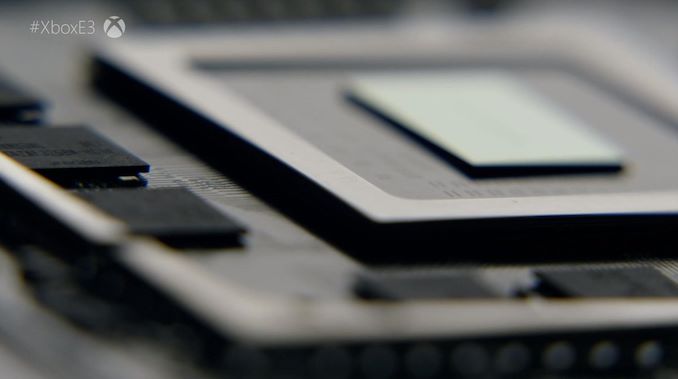Xbox at E3 2019: Xbox Project Scarlett Console Launching Holiday 2020
by Brett Howse on June 9, 2019 5:50 PM EST
Today at E3 Phil Spencer of Microsoft announced Project Scarlett, which is their next generation console and brings some massive performance increases over even the already powerful Xbox One X.
Once again partnering with AMD, Xbox Project Scarlett is, according to Microsoft, the biggest single generation leap in performance they’ve ever delivered, and it starts with its SoC. AMD is leveraging Zen 2 CPUs cores coupled with a Navi-based GPU. And while we don’t have the expected performance figures yet, these components are a big step up over the current generation.
Xbox One X is still based on Jaguar CPUs, which are a limiting factor, and adding Zen 2 is going to be an incredible step up in CPU performance, which has been the limiting factor of the Xbox One X. Coupling that with a Navi based GPU with hardware based Ray Tracing should provide a level of fidelity far above even the Xbox One X. Microsoft’s target for Project Scarlett was announced as 120 FPS (which we assume is at 4K) but also variable refresh rate, and support for up to 8K on the hardware. Microsoft states this console will be four times more powerful than the Xbox One X.
Microsoft is also going to be offering an internal SSD for the first time ever, and they discussed at length how they are going to leverage it to reduce the load times in games, which are a major block to immersion at the moment especially on consoles. Microsoft will be using some of the SSD as a RAM cache as well.
Microsoft also stated that they will continue to their tradition of moving gamers and the games they own onwards with this new launch, so existing Xbox One games and the back-catalog of backwards compatibility games will continue to be playable on the new console as well.
Project Scarlett will be launching in Holiday 2020 along with a new version of Halo to commemorate the launch. Not all details are available yet but we’ll keep you up to date when we hear more.












127 Comments
View All Comments
AshlayW - Sunday, June 9, 2019 - link
Join the Glorious Ryzen Godhood!Opencg - Monday, June 10, 2019 - link
it will beat a pc hands down in value. likely beating what you can get right now for 2x the money. as for side channel mitigations just turn them off. they litteraly don't effect you unless you are running hyper sensitive virtual machinesmode_13h - Tuesday, June 11, 2019 - link
Yeah, he clearly wasn't talking about *value* - just performance in absolute terms. Everybody knows consoles tend to offer better value.Also, you don't know what you're talking about, with side-channel attacks. They don't *only* affect VMs - they affect *even* processes running in another VM, which was once thought to be secure.
However, I will agree that console OS' can potentially disable any side-channel mitigations for games, since they can ensure that web browsers or other avenues for running foreign code are suspended, at the time.
GreenReaper - Monday, June 10, 2019 - link
It's an APU (not that AMD wants to call them that, now) with fast RAM. You could build a rough equivalent once a "4600G" with Zen 2 cores comes out in 2020. It won't be as tightly integrated, and it may cost a bit more - but on the plus side, you'll be able to run anything on it and upgrade it. Including a standalone CPU and graphics card, if it proves insufficient a few years down the road.One question is how much difference GDDR6 vs. DDR5 will make. DDR5 runs at a little under half the bandwidth, but also uses far less power, which will help with cooling:
https://www.tomshardware.co.uk/what-we-know-ddr5-r...
Of course, overclocking may significantly increase the bandwidth to rival that of GDDR6 - and not all games will be limited by the bandwidth.
mode_13h - Tuesday, June 11, 2019 - link
> You could build a rough equivalent once a "4600G" with Zen 2 cores comes out in 2020.No, you can't. AMD never builds APUs with such big iGPUs. The power dissipation would be well beyond what AM4 can handle, and it would be incredibly memory-bottlenecked.
mode_13h - Tuesday, June 11, 2019 - link
BTW, when comparing memory technologies, don't forget to account for data width. AMD's Polaris and (currently-announced) Navi cards use 256-bit memory interfaces, while their AM4 socket uses 128-bit.AshlayW - Sunday, June 9, 2019 - link
My PC can do 120FPS 4K right now!**In Warframe
SlyNine - Monday, June 10, 2019 - link
I'm glad to see the CPU performance step up so much. The worse thing about the Xbox one and PS4 were those crappy ass CPUs. They were holding back innovation. We literally seen a regression in physics last generation with those weak CPU's trying to feed the graphics.Games Goblin - Monday, June 10, 2019 - link
Both Sony and MS talking about raytracing, but AMD did not talk anything about it during the navi reveal - so, will navi have raytracing or not?Yojimbo - Monday, June 10, 2019 - link
My impression is that the Navi about to be released will not support hardware-accelerated raytracing. But these upcoming consoles will be based on custom chips coming out in pate 2020 and they will have hardware accelerated raytracing. Whether AMD will release an updated Navi with raytracing to the PC space in 2020 is anyone's guess. I wouldn't count it out, because NVIDIA is rumored to be coming out with their second generation ray tracing hardware in 2020 and if I am. Not mistaken Intel says they will be making their new discrete GPU available in 2020, too.